
This EarthCache is located at the rest area Vukova Gorica along A1 motorway. Rest area Vukova Gorica is accessible both for southbound and for northbound traffic.
This EarthCache will teach you some basic geological principles and you will see some nice rocks that illustrate at least some of these basic geological principles.
EarthCache
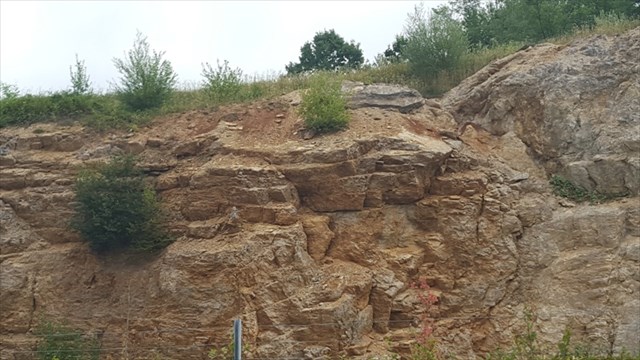
Steno's Principles
Nicolas Steno was a Danish scientist, a pioneer in geology and he is considered the father of modern stratigraphy (field of geology which studies rock layers) and modern geology in general. Back in 1669, Steno wrote a thesis about rock layers and introduced four principles of stratigraphy that are still considered valid.
These principles are:
(1) Principle of superposition,
(2) Principle of lateral continuity,
(3) Principle of original horizontality,
(4) Principle of cross-cutting relationships.
Principle of Superposition
Nicolas Steno: „At the time when any given stratum was being formed, all the matter resting upon it was fluid, and, therefore, at the time when the lower stratum was being formed, none of the upper strata existed.“
According to this principle, in any section of undisturbed layers of sedimentary rocks, the rock layers below are older than the rock layers above. Oldest rock layer is at the bottom and the youngest is at the top.
Principle of Superposition
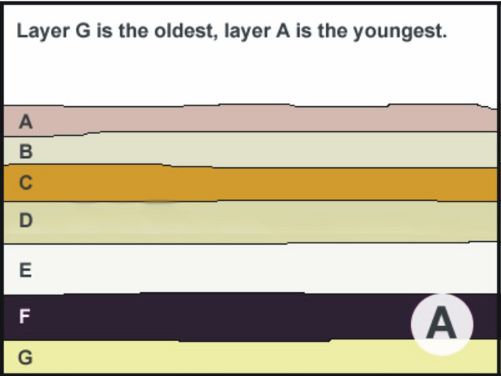
Source: Earth Science, Palo Alto: CK-12 Foundation, 2009.
Principle of Lateral Continuity
Nicolas Steno: „Materials forming any stratum were continuous over the surface of the Earth unless some other solid bodies stood in the way.“
This principle states that layers of sediment, that formed sedimentary rocks, initially spread out in all directions until they reach some other object or physical boundary. As a result, rocks that are otherwise similar, but are now separated by a valley or other erosional feature, can be assumed to be originally continuous or connected. This principle allows geologists to link identical rocks on opposite sides of, for example, river valley and deduce the history of events that separated them.
Principle of Lateral Continuity
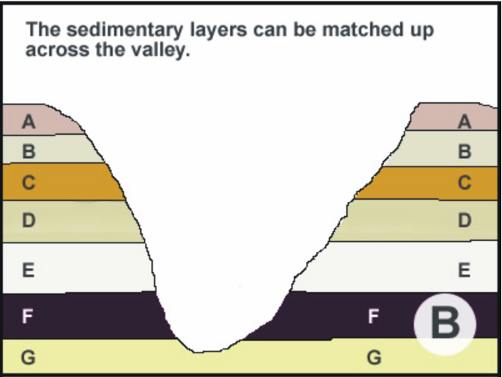
Source: Earth Science, Palo Alto: CK-12 Foundation, 2009.
Principle of Original Horizontality
Nicolas Steno: „...strata either perpendicular to the horizon or inclined to it, were at one time parallel to the horizon.“
This principle states that sedimentary rock are usually formed in a horizontal position. So, if rock layers are now vertical, or tilted at some other angle, or folded, they have been moved from their original, horizontal position by some natural force after their formation (e.g. earthquake). Although today geologists know that some rock layers start out tilted, this principle is still important because it enables detection of unusual degrees of tilt and conclusion that such rock layers have been disturbed since their formation.
Principle of Original Horizontality
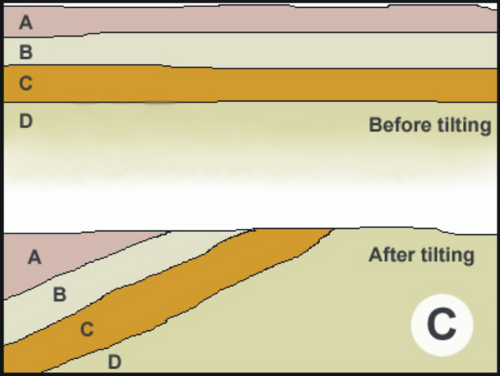
Source: Earth Science, Palo Alto: CK-12 Foundation, 2009.
Principle of Cross-Cutting Relationships
Nicolas Steno: „If a body or discontinuity cuts across a stratum, it must have formed after that stratum.“
In cases where one type of rock cuts across or through another type of rock, the rock being cut is older and the rock cutting through is younger. This principle is applicable for all types of rocks, not only for sedimentary rocks.
Principle of Cross-Cutting Relationships
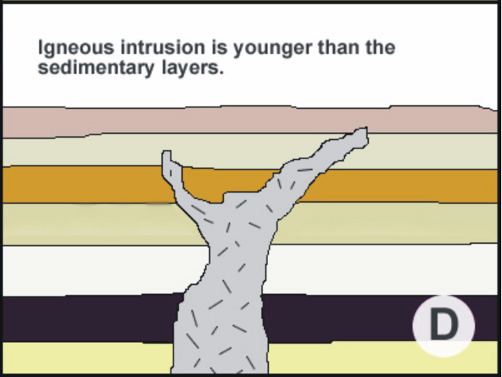
Source: Earth Science, Palo Alto: CK-12 Foundation, 2009.
Relative Age
All these Steno's principles (and some other principles as well) are important for relative dating of geological events. Relative dating determines relative age of some geological feature, i.e. its age in comparison with other geological features. This method of dating can say which rock is older and which is younger, but it doesn't tell how many years some rock is old. Other techniques are used for determining how many years some rock is old. This numerical age is called absolute age and techniques for determining absolute age are called absolute dating. Radiometric dating is an example of absolute dating method that is used in geology.
Logging Tasks
To log this EarthCache answer the following questions:
1. Observe rocky outcrop at the EarthCache location. For how many of Steno's principles can you find examples at this location? Which principles are they? Describe examples that you find at the location.
2. Perform relative dating on rock layers at EarthCache location. Report your findings.
Send your answers through my profile at geocaching.com (through e-mail or message center) and NOT in a log. You don't have to wait for me to approve your answers. Once you send your answers feel free to log the cache as found. If there are problems with your answers, I will contact you.
Sources
1. Geologic Time, Course Notes, EarthCache Academy.
2. Alecia M. Spooner, Geology for Dummies, Hoboken: Wiley Publishing, Inc., 2011.
3. Earth Science, Palo Alto: CK-12 Foundation, 2009.
4. Geology.About.com
5. Wikipedia.org

Ovaj EarthCache se nalazi na odmorištu Vukova Gorica na A1 autocesti. Odmorište Vukova Gorica je dostupno vozilima iz oba smjera.
Uz ovaj EarthCache ćete naučiti ponešto o osnovnim geološkim načelima, te ćete moći vidjeti lijepe primjerke stijena koje ilustriraju barem neke od navedenih geoloških načela.
EarthCache

Stenova načela
Nicolas Steno je bio danski znanstvenik, pionir u području geologije, te se danas smatra ocem moderne stratigrafije (područje geologije koje proučava slojeve stijena) kao i moderne geologije uopće. Godine 1669. Steno je napisao rad o slojevima stijena, te je u tom radu definirao četiri načela stratigrafije koji se i danas još smatraju valjanima.
Navedena načela su:
(1) Načelo superpozicije,
(2) Načelo bočnog kontinuiteta,
(3) Načelo originalnog horizontaliteta,
(4) Načelo kosog presjecanja.
Načelo superpozicije
Nicolas Steno: „U trenutku kada je bilo koji sloj bio formiran, sva materija kojaje bila iznad njega je bila tekuća, i stoga kada je formiran niži sloj, niti jedan gornji sloj još nije postojao.“
Prema ovom načelu, u bilo kojem dijelu neporemećenih slojeva sedimentnih stijena, slojevi koje se nalaze ispod su stariji od onih koji se nalaze iznad. Najstariji sloj stijena se nalazi na dnu, a najmlađi se nalazi na vrhu.
Načelo superpozicije

Izvor: Earth Science, Palo Alto: CK-12 Foundation, 2009.
Načelo bočnog kontinuiteta
Nicolas Steno: „Tvar koja čini bilo koji sloj je bila neprekinuto rasprostranja preko površine Zemlje osim ukoliko se neko kruto tijelo nije bilo našlo na putu.“
Ovo načelo kazuje da su se slojevi sedimenta koji su formirali sedminetnu stijenu u početku rasprostirali u svim smjerovima sve dok nisu naišli na neki objekt ili fizičku prepreku. Stoga se za stijene koje su u svim drugim pogledima slične, ali su sada odvojene nekom dolinom ili nekim drugim erozijskim objektom, može pretpostaviti da su originalno bile spojene. Ovo načelo omogućava geolozima povezivanje identičnih stijena na suprotnim stranama riječne doline i donošenje zaključaka o geološkim događajima koji su ih razdvojili.
Načelo bočnog kontinuiteta

Izvor: Earth Science, Palo Alto: CK-12 Foundation, 2009.
Načelo originalnog horizontaliteta
Nicolas Steno: „...slojevi koji su okomiti ili pod određenim kutem u odnosu na horizont, su u nekom trenutku bili paralelni s horizontom.“
Ovo načelo kazuje da su sedimentne stijene najčešće formirane u horizontalnom položaju. Ukoliko je sloj stijena sada vertikalan ili nagnut pod nekim drugim kutem ili presavijen, taj sloj je pomaknut u odnosu na njegov originalan, horizontalan položaj nekom prirodnom silom nakon formiranja sloja (npr. zemljotresom). Iako danas geolozi znaju da su neke stijene formirane nagnute u odnosu na horizont, ovo načelo je još uvijek važno jer omogućava otkrivanje neuobičajenih stupnjeva nagnutosti i donošenje zaključaka o njihovom pomicanju nakon formiranja.
Načelo originalnog horizontaliteta

Izvor: Earth Science, Palo Alto: CK-12 Foundation, 2009.
Načelo kosog presjecanja
Nicolas Steno: „Ako tijelo ili diskontinuitet presjeca kroz sloj stijena, tada je ono nastalo nakon tog sloja.“
Kada jedna vrsta stijena presjeca kroz drugu vrstu stijena, tada je stijena kroz koju se presjeca starija, a stijena koja presijeca je mlađa. Ovo načelo je primjenjivo za sve vrste stijena, a ne samo za sedimentne stijene.
Načelo kosog presjecanja

Izvor: Earth Science, Palo Alto: CK-12 Foundation, 2009.
Relativna starost
Sva prethodno navedena Stenova načela (kao i neka druga načela) su važna za određivanje relativne starosti geoloških događaja. Relativno datiranje određuje relativnu starost nekog geološkog obilježja. Ova metoda datiranja može odgovoriti na pitanje koja stijena je starija, a koja mlađa, ali ova metoda ne može odrediti koliko godina je pojedina stijena stara. Druge tehnike se koriste za određivanje koliko je milijuna godina neka stijena stara. Brojčano određena dob se naziva apsolutna starost, a njezino određivanje se naziva apsolutno datiranje. Radiometrijsko datiranje je jedan primjer metode apsolutnog datiranja koje se koristi u geologiji.
Zadaci za logiranje
Kako biste logirali ovaj EarthCache odgovorite na sljedeća pitanja:
1. Promotrite stijene na lokaciji ovog EarthCachea. Za koliko Stenovih načela možete pronaći primjere na ovoj lokaciji? Koja su to načela? Opišite primjere koje ste pronašli na lokaciji.
2. Provedite relativno datiranje slojeva stijena na lokaciji EarthCachea. Opišite svoje zaključke.
Odgovore pošaljite preko mog profila na geocaching.com, a NE u Vašem logu! Ne morate čekati na moje potvrđivanje Vaših odgovora. Jednom kada pošaljete Vaše odgovore slobodno logirajte pronalazak ovog EarthCachea. Ako Vaši odgovori budu pogrešni ja ću kontaktirati Vas.
Izvori
1. Geologic Time, Course Notes, EarthCache Academy.
2. Alecia M. Spooner, Geology for Dummies, Hoboken: Wiley Publishing, Inc., 2011.
3. Earth Science, Palo Alto: CK-12 Foundation, 2009.
4. Geology.About.com
5. Wikipedia.org